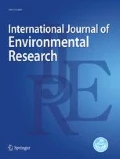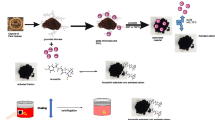Abstract
The use of phosphate rock (PR), porcelanite (PC) and granite (GR) as natural locally abundant adsorbents compared with adsorption by granular activated carbon (GAC) for removing pharmaceuticals including sulfamethoxazole (SMX), sulfapyridine (SP) and carbamazepine (CBZ) from simulated wastewater was examined. The removal efficiency of the three pharmaceuticals was found to follow the consequences as: PC ˃ GAC ˃ PR ˃ GR. The uptake efficiency of sulfamethoxazole was 91.51, 86.69, 69.51 and 53.97% onto PC, GAC, PR and GR, respectively, at initial concentration, pH, dosage and temperature of 50 mg/L, 4, 0.5 g/100 mL and 30 °C, respectively. The removal efficiency of sulfapyridine was 84.71, 81.97, 63.25 and 49.71%, respectively. However, for carbamazepine it was 80.46, 79.61, 54.10 and 43.44%, respectively. Fourier transform Infrared (FTIR) was carried out for PC before and after adsorption to determine the type of functional groups. Carbonyl and hydroxyl functional groups on the surface of PC were the major groups responsible for adsorption process. The effect of pH (5, 7 and 9), agitation speed (50–300 rpm), dosage (0.1–1.4 g/100 mL), contact time (30–360 min), temperature (10–60 °C) and initial concentration (25–100 mg/L) are studied to find out the optimum conditions for removing the selected pharmaceuticals using PC. Adsorption isotherms and kinetic models had been used to fit the experimental data. From which Langmuir and pseudo-second order models were found to be more represented to the experiments with high correlation coefficient for the three pharmaceuticals.
Article Highlights
-
The demand for pharmaceuticals and personal care products (PPCPs) has nearly paralleled the escalating population.
-
The prolonged use of PPCPs has led to evident emergence in the environment, creating the potential for adverse consequences to ecosystems and human health.
-
Current water and wastewater treatment processes, such as advanced oxidation, photolysis, and adsorption have shown some success in the removal of SMX, SP, and CBZ.













Similar content being viewed by others
References
Alexander PM, Zayas I (1989) Particle size and shape effects on adsorption rate parameters. Environ Eng 115:41–55
Ali AH (2013) Comparative study on removal of cadmium(II) from simulated wastewater by adsorption onto GAC, DB, and PR. Desalination Water Treat J 51(28–30):5547–5558
Ali AH (2014) Removal of cd2+, cu2+, and ni2+ metals from simulated wastewater in single and competitive systems using local iraqi phosphate rocks. Chem Eng Commun 201(12):1620–1644
Ali N, Habibeh Sh, Fatemeh Gh, Ahmad Z (2016a) Synthesis of walnut shell modified with titanium dioxide and zinc oxide nanoparticles for efficient removal of humic acid from aqueous solutions. J Water Health 14(6):989–997
Ali AH, Younis S, Lahieb F, Ali Q (2016b) Selecting of an effective adsorbent for treating phosphate contamination. J Eng Sustain Dev 20(5):136–1155
Aliakbar D, Ahmad Z, Jalil J, Mahmoud S, Kh Amin M (2019) Tetracycline removal from aqueous solutions using Zeolitic Imidazolate frameworks with different morphologies: a mathematical modeling. Chemosphere 217:250–260
Al-Qodah Z (2006) Biosorption of heavy metal ions from aqueous solutions by activated sludge. Desalination 196:164–176
Andreozzi A, Raffaele M, Nicklas P (2003) Pharmaceuticals in STP effluents and their solar photodegradation in aquatic environment. Chemosphere 50:1319–1330
Anness E, Conoby K (2013) Removal of sulfamethoxazole from water by ion-exchange adsorption, major qualifying project completed in partial fulfillment of the Bachelor of Science Degree at Worcester Polytechnic Institute, Worcester, MA
Armenante P (1999) Ion exchange [PowerPoint slides]. http://cpe.njit.edu/dlnotes/CHE685. Accessed 25 Feb 2013
Beltrán F, Aguinaco A, Garía-Araya J, Oropesa A (2008) Ozone and photocatalytic processes to remove the antibiotic sulfamethoxazole from water. Water Res 42(14):3799–3808
Bhandari A, Close L, Kim W, Hunter R, Koch D, Surampalli R (2008) Occurrence of ciprofloxacin, sulfamethoxazole, and azithromycin in municipal wastewater treatment plants. Pract Periodical Hazard Toxic Radioactive Waste Manag 12:275–281
Boxall A (2012) Pharmaceuticals and personal care products in the environment: what are the big questions? Environ Health Perspect 120:1221–1229
Chiou C (2002) Partition and adsorption of organic contaminants in environmental systems. Wiley, Hoboken
Dantas R, Contreras S, Sans C, Esplugas S (2008) Sulfamethoxazole abatement by means of ozonation. J Hazard Mater 150(3):790–794
Daughton CG (2004) PPCPs in the environment: future research C beginning with the end always in mind. In: Kümmerer K (ed) Pharmaceuticals in the environment, 2nd edn. Springer, pp 463–495
Davis ML (2009) Air pollution. In: Masten SJ (ed) Principles of environmental engineering and science, 2nd edn. McGraw-Hill Higher Education, Boston, pp 572–573
De Dardel F (2010) Ion exchange. http://dardel.info/IX/index.html. Accessed 25 Feb 2013
Dodd M, Huang C (2004) Transformation of the antibacterial agent sulfamethoxazole in reactions with chlorine: kinetics, mechanisms, and pathways. Environ Sci Technol 38(21):5607–5615
Dorris KL, Yu B, Zhang Y, Shukla A, Shukla S (2000) The removal of heavy metal from aqueous solutions by sawdust adsorption–removal of copper. J Hazard Mater 80:33–42
Droste RL (1997) Theory and practice of water and wastewater treatment. Wiley, Technology & Engineering
García-Galán MJ, Días-Cruz M, Barceló D (2008) Identification and determination of metabolites and degradation products of sulfonamide antibiotics. TrAC Trends Anal Chem 27(11):1008–1022
Hamadi N, Ahmed A, Ali AH (2014) Removal of Pb2+, Cu2+ and Cd2+ metals from simulated wastewater in single and competitive system using locally porcelanite. Int J Eng Sci Res Technol 3(7):245–257
Hammaini A, Ballester FA, Blazquez ML, Munoz JA (2006) Biosorption of heavy metals by activated sludge and their desorption characteristics. J Environ Manage 84:419–426
IMS Insitute for Healthcare Informatics (2012) The global use of medicines: outlook through 2016. http://www.imshealth.com/deployedfiles/ims/Global/Content/Insights/IMSInstituteforHealthcareInformatics/GlobalUseofMeds2011/Medicines_Outlook_Through_2016_Report.pdf. Accessed 10 Feb 2013
Ma QY, Traina SJ, Logan TJ, Ryan JA (1995) Lead immobilisation from aqueous solutions and contaminated soils using phosphate rocks. Environ Sci Technol 29:1118–1126
Mohammad H, Elham N, Ahmad Z, Niaz M (2017a) The effects of US/H2O2 process on bisphenol-A toxicity in aqueous solutions using Daphnia magna. Desalination Water Treat 68:183–189
Mohammad H, Ahmad Z, Alireza M, Ramin N, Mahmood A, Mojtaba A (2017b) Adsorption of Cr(VI) ions from aqueous systems using thermally sodium organo-bentonite biopolymer composite (TSOBC): response surface methodology, isotherm, kinetic and thermodynamic studies. Desalination Water Treat 85:298–312
Mohammad H, Mansoureh F, Mahmood A, Mojtaba A, Gordon M (2018) Adsorptive removal of fluoride from water by activated carbon derived from CaCl2-modified Crocus sativus leaves: equilibrium adsorption isotherms, optimization, and influence of anions. Chem Eng Commun 205(7):955–965
Niu J, Zhang L, Li Y, Zhao J, Lv S, Xiao K (2012) Effects of environmental factors on sulfamethoxazole photodegradation under simulated sunlight irradiation. J Environ Sci 24:1098–1106
Pouretedal H, Sadegh N (2014) Effective removal of Amoxicillin, Cephalexin, Tetracycline and Penicillin G from aqueous solutions using activated carbon nanoparticles prepared from vine wood. J Water Process Eng 1:64–73
Rasoul K, Ahmad Z, Mohsen H, Ali A, Mehdi V, Mehdi F (2018) Application of ZnO and TiO2 nanoparticles coated onto montmorillonite in the presence of H2O2 for efficient removal of cephalexin from aqueous solutions. Korean J Chem Eng 35(4):1000–1008
Sag Y, Kutsal T (2000) Determination of the biosorption heats of heavy metal ions on Zoogloea and Rhizopusarrhizus. Biochem Eng J 6:145–151
Stoykova M, Koumanova B, Mörl L (2013) Adsorptive removal of carbamazepine from wastewaters by activated charcoals. J Chem Technol Metall 48(5):469–474
Sulaymon AH, Abbood DW, Ali AH (2012a) Removal of phenol and lead from synthetic wastewater by adsorption onto granular activated carbon in fixed bed adsorbers: prediction of breakthrough curves. Desalination Water Treat 40(1–3):244–253
Sulaymon AH, Abbood DW, Ali AH (2012b) Competitive adsorption of phenol and lead from synthetic wastewater onto granular activated carbon. J Environ Sci Eng 5(2011):1389–1399
Sulaymon AH, Abbood DW, Ali AH (2013) A comparative adsorption/biosorption for the removal of phenol and lead onto granular activated carbon and dried anaerobic sludge. Desalination Water Treat 51(10–12):2055–2067
Tlaiaa YS (2014) Performance of coagulation/adsorption for removal of reactive dyes from textile wastewater, MSc. Thesis, University of AL-Mustansiriya, College of Engineering
Wu Y, Tang Y, Li L, Liu P, Li X, Chen W, Xue Y (2019) Adsorption of U(VI) ions from aqueous solution using nanogoethite powder. Adsorpt Sci Technol 37(1–2):113–126
Yasemin B, Tez Z (2007) Adsorption studies on ground shells of hazelnut and almond”. J Hazard Mater 149:35–41
Ying Y, Yan Z, Bin G, Renjie C, Feng W (2017) Removal of sulfamethoxazole (SMX) and sulfapyridine (SPY) from aqueous solutions by biochars derived from anaerobically digested bagasse. Environ Sci Pollut Res 25(26):25659–25667
Acknowledgements
The authors would like to thank Mustansiriyah University (http://www.uomustansiriyah.edu.iq) for their support to the authors during completion of this work.
Author information
Authors and Affiliations
Corresponding author
Rights and permissions
About this article
Cite this article
Ali, A.H. Removal of Sulfamethoxazole, Sulfapyridine and Carbamazepine, from Simulated Wastewater Using Conventional and Nonconventional Adsorbents. Int J Environ Res 13, 487–497 (2019). https://doi.org/10.1007/s41742-019-00192-x
Received:
Revised:
Accepted:
Published:
Issue Date:
DOI: https://doi.org/10.1007/s41742-019-00192-x




